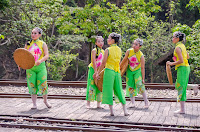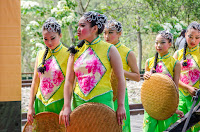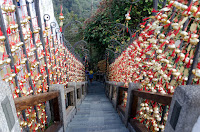Day 13: Checheng
When we boarded the minibus to Checheng, it was somewhat empty, but filled on the way, exclusively with old Taiwanese women, who later collectively exited at the Shuili Train Station. We had planned to exit the bus first at the Shui-li Snake Kiln and had told that (or better shown, printed out in Chinese) to the minibus driver. Unfortunately, he forgot and also we didn´t know, that the Sheyao Bus Stop is the bus stop at the Snake Kiln. So we failed to press a button on the bus to stop when this stop was announced on the English service electronic display. But we only fully realised that we must be past the Snake Kiln when we had reached the Shuili Train Station, where all the old Taiwanese ladies exited.
Behind the building with the exhibitions, there was also an attached large park, that we walked through. There we could see the Taiwanese plants in nature. The many snake and wasp warning signs made it even more exciting to walk through the park.
We had to skip breakfast at our beautiful Skylight B & B in Ita Thao Village at the Sun Moon Lake. We had planned to visit three places south of the Sun Moon Lake - Checheng Village (to visit a wood museum), Jiji (an earthquake temple) and Shui-li Snake Kiln (a ceramics cultural park). To manage to see them all in one day, we needed to take the first bus. That Bus 6671, which ply between Shueishe, the Snake Kiln and Checheng, left in front of the Shueishe Visitor Center at 8.10 a.m. To reach it, we had to take the first bus of the "Lake Tour Bus" from Ita Thao to Shueishe, which leaves at 7 a.m.
When we boarded the minibus to Checheng, it was somewhat empty, but filled on the way, exclusively with old Taiwanese women, who later collectively exited at the Shuili Train Station. We had planned to exit the bus first at the Shui-li Snake Kiln and had told that (or better shown, printed out in Chinese) to the minibus driver. Unfortunately, he forgot and also we didn´t know, that the Sheyao Bus Stop is the bus stop at the Snake Kiln. So we failed to press a button on the bus to stop when this stop was announced on the English service electronic display. But we only fully realised that we must be past the Snake Kiln when we had reached the Shuili Train Station, where all the old Taiwanese ladies exited.
It was no problem, however, as the bus continues to Checheng and so we decided to go there first and to the Snake Kiln on the way back to the Sun Moon Lake. We didn't say anything, but the bus driver realised, he forgot something, when we were the only guests exiting in Checheng - he looked abashed and said sorry several times. It was actually not wrong to be in Checheng early. It was already sunny and getting warm, and there weren't droves of tourists yet, so it was somewhat serene. It is a very green village in the mountains, and we were greeted nicely when we entered the tourist office first. A friendly Taiwanese woman (who can speak a bit of English) gave us a map of the village and recommended to go to the lake early.
The village, which is dedicated to wood, is tiny and so we first stopped at a huge tourist shop, where I got a wooden massage-thing for the head and then walked the few steps to the little lake. It´s a beautiful lake amidst the mountainous scenery, flanked by tea houses. What I especially like, is, that the artificial lake was part of an industrial site earlier and when the industry disappeared they made this into a green area. Now it looks like a park and the whole town like a recreational area. Checheng, however still preserved the original appearance. Color-faded walls, tiny houses lived by locals, water tanks on house roofs and abandoned houses, all of which make this village full of history.
From the lake, we walked to the Checheng Old Street, where most shops were still closed, and continued to the Checheng Train Station, which was remnants of the logging companies of the 1960's. We decided to buy return tickets (which cost just about 2 Euro) to Jiji and were told that we can use any trains on the line with the tickets - they weren't bound for a specific departure, which was great.
Opposite the train station was the Checheng Wood Museum. We decided to check it out since we still have a lot of time.
From the wood museum, we wanted to go back to the railway station to continue our sightseeing trip to Jiji, but heard music and followed it. It looked like there was a festival about to begin. The train that we wanted to take would leave soon, but we could stay long enough to see some traditional (I guess) dancing performance.
From the lake, we walked to the Checheng Old Street, where most shops were still closed, and continued to the Checheng Train Station, which was remnants of the logging companies of the 1960's. We decided to buy return tickets (which cost just about 2 Euro) to Jiji and were told that we can use any trains on the line with the tickets - they weren't bound for a specific departure, which was great.
Opposite the train station was the Checheng Wood Museum. We decided to check it out since we still have a lot of time.
From the wood museum, we wanted to go back to the railway station to continue our sightseeing trip to Jiji, but heard music and followed it. It looked like there was a festival about to begin. The train that we wanted to take would leave soon, but we could stay long enough to see some traditional (I guess) dancing performance.
Checheng Train Station is the terminal for the Jiji Line, which is served by several trains a day. We boarded the train going to the historic Jiji Station, which was just two stations away. While the train station is indeed beautiful, the main reason for our visit in Jiji was a partly destroyed temple, who fell victim to the devastation in Jiji Earthquake of 1999.
Before visiting the temple, we walked along the main road for about 2 kilometres eastward to visit the Endemic Species Research Institute. We came along some fields where they grow dragon fruit, bananas and much more. Jiji seems to be exceptionally proud of its bananas, as there were some statues too, that included bananas.
Before visiting the temple, we walked along the main road for about 2 kilometres eastward to visit the Endemic Species Research Institute. We came along some fields where they grow dragon fruit, bananas and much more. Jiji seems to be exceptionally proud of its bananas, as there were some statues too, that included bananas.
The Endemic Species Research Institute had several large exhibitions of wildlife and the flora of Taiwan, that even included interactive elements, like pressing a button to hear an animal. In the basement, you can also watch the roots section. It is a rather large site, and we were surprised, that we were pretty much the only guests - it really deserves more guests.
Behind the building with the exhibitions, there was also an attached large park, that we walked through. There we could see the Taiwanese plants in nature. The many snake and wasp warning signs made it even more exciting to walk through the park.
We also visited their butterfly garden, that was however much less interesting than the butterfly garden we had seen in Cambodia earlier in the tour. I really wanted to eat by now, but unfortunately, the more prominent restaurant had closed, and the smaller facility was more like a shop and didn´t look that inviting. So we decided to walk to the temple next.
The Wuchang Temple partly collapsed at the Jiji Earthquake in 1999. The ruin, however, was not removed but fenced. It now is a reminder of the earthquake. When we walked there, we first came to a new looking temple and thought, the old one may have been removed after all. But the "earthquake temple" was just behind it. It reminded me a bit of the "Buried Houses" we had seen last year on our trip to Japan in Shimabara.
When we were taking photos, I came to talk to a Taiwanese man, who told us, that he currently lives in the United States and is visiting his family in Taiwan. He was very friendly and offered to be our interpreter when we visited the small market next to the temples. There was interesting stuff on display, and we were asked to taste a lot and finally bought dried and shrivelled black bananas.
From the temples, we walked back to the Jiji Train Station. We had to hurry a bit because we wanted to get the next train towards Checheng, exit the train after one station in Shuili Train Station and then take the bus 6671 from the front of the train station to our next point of interest, the Shui-li Snake Kiln.
We had to run a bit but managed to get there just in time and then also only reached the bus in time, and this time the driver let us out at Sheyao Bus Stop, which is the bus stop at the Snake Kiln. From the bus stop, we found a sign and then it was just a short walk to the Snake Kiln, a ceramics cultural park.
At the Shui-li Snake Kiln, we visited the Snake Kiln Museum, the gallery and also viewed a lot of pottery, including a massive vase. You can even watch the creation of pottery and visit pottery classes. It was pleasant stop. We took our time to look around. On the way back I bought a cold drink at a booth in front of the entrance, and we walked back to the bus stop, where we later signalled the bus 6671 to stop for us. We immediately recognised the same bus driver who brought us earlier to Checheng.
We had to run a bit but managed to get there just in time and then also only reached the bus in time, and this time the driver let us out at Sheyao Bus Stop, which is the bus stop at the Snake Kiln. From the bus stop, we found a sign and then it was just a short walk to the Snake Kiln, a ceramics cultural park.
At the Shui-li Snake Kiln, we visited the Snake Kiln Museum, the gallery and also viewed a lot of pottery, including a massive vase. You can even watch the creation of pottery and visit pottery classes. It was pleasant stop. We took our time to look around. On the way back I bought a cold drink at a booth in front of the entrance, and we walked back to the bus stop, where we later signalled the bus 6671 to stop for us. We immediately recognised the same bus driver who brought us earlier to Checheng.
After following the curvy road through the mountains, the bus soon brought us back to the bus stop in front of the Shueishe Visitor Center at the Sun Moon Lake. There we entered the "Lake Tour Bus". It wasn´t yet the last bus from Shueishe back to Ita Thao for the day, so we decided to exit the bus at the Wenwu Temple. There we climbed up the massive temple complex to the top to get another Sun Moon Lake view and also saw many beautiful ornaments.
From the bus stop at the Wenwu Temple, we later took the next "Lake Tour Bus" back to Ita Thao, where we bought street food for dinner and then enjoyed the Sun Moon Lake view at the pier. On the next day, we had to leave the Sun Moon Lake. Actually, we could have used the extra time there - with a day more we would have taken a day trip to Puli to visit the Chung Tai Chan Monastery and maybe the Liyu Lake and the Puli Brewery. Oh well, that would probably be for the next time. There´s also a Taiwan Tourist Shuttle Route that leads to other attractions like the Paper Dome. There are many busses to Puli and even some from the Sun Moon Lake to Alishan.




























































































































































No comments:
Post a Comment